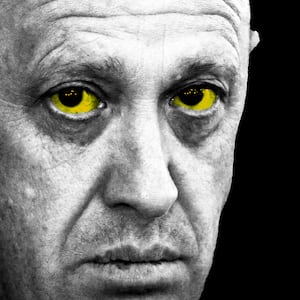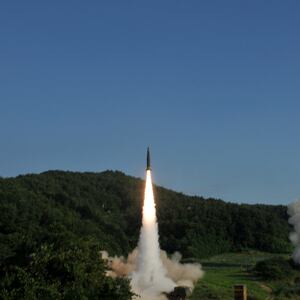NEAR ANDRIIVKA, Ukraine—A young man emerged from the basement bleeding from his stomach. With his mohawk, pierced ears, and tattoos, everyone calls him ‘Cossack’ because of his similarity to the 17th century Ukrainian swashbucklers.
Smoke was rising from all sides from the recent Russian shelling salvos all around us, although the countryside was eerily quiet. He was still grinning and excitedly sharing a story as he entered the ambulance with us. “They only killed their own,” he would later relay to us from the relative safety of a nearby hospital. “They fired at our positions, and the only person they killed was one of our prisoners who we had captured a few days ago.”
Knowing it wouldn’t be long until the artillery battle resumed, we hightailed it. Normally, injured soldiers are transported from the front in an armored medevac vehicle. But casualties had been so high today that they had run out of suitable vehicles, so the medics had to take a chance on the open road to the trenches in a soft-skinned ambulance. Cossack told us it had no way of stopping an artillery shell.
ADVERTISEMENT
A few miles in front of us was the town of Andriivka, which Cossack’s brigade had been fighting towards since the beginning of Ukraine’s counteroffensive in June. It’s around six miles south of Bakhmut, which fell to Russian Wagner fighters in May, soon after which Wagner chief Yevgeny Prigozhin fell out with the Ministry of Defence and launched an abortive putsch, before being killed in a mysterious plane crash.
The soldiers say that the recruits that have replaced Wagner in the Bakhmut sector are less well-trained, poorly equipped, and more liable to flee—it is still a very tough fight, but the scales have tipped in their favor.

Mathew, right, treats an injured Ukrainian soldier nicknamed Cossack.
Óskar Hallgrímsson“Now we’re fighting a conventional Russian army, but before Bakhmut fell, the Wagner group was in the area, and they had a particularly terrible approach to this. The group sent forward unarmed men, mostly prisoners, with ammunition for the next group who were experienced mercenaries. They thus used the prisoners as a meat transport machine for ammunition and equipment,” says Mathew, a medic with Ukraine’s Third Assault Brigade. He took The Daily Beast in his ambulance to watch them picking up soldiers like ‘Cossack’ from the front line and delivering them to hospitals for emergency treatment. This approach, they say, was uncomfortably effective. “They had no fear” he says, because the consequences of retreat were “certain death”
Michael Kofman of the Center for Naval Analysis told The Daily Beast: “Wagner troops were better motivated, but in the Stalinist tradition that in Wagner it took more courage to retreat than to attack”—knowing they would be shot at any sign of retreat. He notes that they also had “a significant artillery advantage provided by the Russian military (hence Prigozhin’s endless arguments for more munitions), having their flanks secured by the Russian airborne, and a large supply of expendable fighters from the Russian prison system,” all of which are lacked by the current Russian forces. He also points out that “Wagner had not been used, or set up, as a defensive force in this war and so it is unclear how they would have performed on the defense around Bakhmut’s flanks.”
Since Wagner vanished, Matthew says the quality of the Russian soldiers has declined and the men are more likely to flee or let their lines break under pressure. “The ones we meet don’t even pick up their dead,” he said.

Mathew, a medic with Ukraine’s Third Assault Brigade.
Óskar HallgrímssonThe day we visited was the day they had finally reached their goal of taking back the village of Andriivka, which had taken more than two months. Its capture allows Ukraine to threaten one of the key supply lines into Bakhmut, a major step to encircling Russians inside the city. “We know the price; every kilometer is paid for with the blood of our guys," Matthew told us. They had smashed the remaining Russian positions in the village with artillery before infantry units moved in to mop up the last pockets of resistance. Before the war, in a different life, Matthew was an interior designer. Constantly concerned for the safety of our team, and never comfortable with a weapon in his hands, he is not a natural soldier. “We need you to stay safe here—the world needs you to show what fucking Russians do on Ukrainian lands.”
When we arrived back at a designated evacuation point, the location of which we were asked not to identify, it was a blur of movement. Several armored vehicles had brought injured men from other parts of the front. The Russians had learned that the Ukrainians had completely taken Andriivka, and had blasted the town with a mass artillery barrage in revenge.

Ukrainian soldiers.
Óskar HallgrímssonMatthew, along with the rest of his unit, has fought in and around Bakhmut since January this year. It is an entirely volunteer unit, with little fancy Western kit such as Leopard tanks or Bradley Fighting Vehicles. Old Soviet-era equipment, including T-72 tanks, is constantly trundling down the road next to us. At night, we see flames bursting into the sky in front of us as a GRAD rocket launcher fires towards Russian positions. Yet the brigades here have achieved some of the counteroffensive’s most notable successes, and the brigade believes that their extensive combat experience matters more than whatever weapons they receive.
They are not just in danger from enemy soldiers, however—they also face an enemy within. As we sat down for a meal in a civilian home in the nearby city of Kostiantynivka, Matthew confided that many of the locals in the area still see the Ukrainians as the enemy. “These women are some of the only civilians we trust here. Too many of the people still here are waiting for the Russians. I can’t understand this mindset.” The Russians offer the locals as little as $100 for information on both potential civilian targets and Ukrainian military positions. He recalls once opening his window at a base and seeing a civilian filming the soldiers on his phone from outside. He tells me: “I nearly shot him in the face right there.”
After a missile strike on a pizza restaurant in Kramatorsk in June, the SBU arrested a man they accused of filming the scene and sending it to Russian military handlers.

An injured Ukrainian soldier receives treatment.
Óskar HallgrímssonStanislav, a drone operator with a unit fighting further north, near the town of Kreminna, says another major boost for Ukrainian forces has been the arrival of U.S.-made cluster munitions. The weapons are highly controversial because they leave bomblets that can fail to explode and remain a hazard to civilians for decades after the conflict is over. Ukrainian soldiers do not take this argument seriously. “I’ve seen them working, and as soon as we fire, the Russians scatter, they hide,” Stanislav told The Daily Beast. Before their arrival, Ukrainian forces were losing ground in this region to a Russian offensive. Now, this has largely stalled.
“The counteroffensive is going well,” he says, but what he fears most is a longer war. “Everyone who wanted to fight signed up long ago,” he says from a café in the city of Slovyansk. “If the Russians wanted to, they have millions of men they can mobilize. We are at our total limit.”
Whether Ukrainian successes in this area will be enough to consolidate their gains remain to be seen. In the month since Andriivka was captured, Ukrainian gains in the area have slowed, although the soldiers claim they are consolidating for further pushes east. Similarly, the Russians have launched a major offensive of their own in the area, targeting the town of Avdiivka next to the Russian occupied city of Donetsk. However, despite using an enormous amount of armor and artillery, the assault seems to have been largely beaten back. Matthew says, “The Russians attack, but have no results, they take some points, but just temporarily. In our direction we’ve done a great job. Now, we take a break to recover and stay in reserve. I think it will be a hot winter.”
While the Ukrainians have inflicted heavy losses on the Russians, these developments show the Russians still have combat capability in the area. It also shows the difficulty of making serious advances now that Ukraine’s front lines have been so heavily fortified on both sides. The soldiers know it will be a long time before they free the rest of their lands. “Here is the spirit of brotherhood. We all know our limitations and strengths, and what we can do for the country,” says Mario, a 22-year-old paramedic. On Feb. 24 2022—the day Russia’s full-scale invasion began— he and his father signed up for the army first thing in the morning. He was four years through a medical degree at Ukraine’s top university. “My family keep asking when I will come back and finish my studies,” he says. “I tell them that I’m still needed here.”








